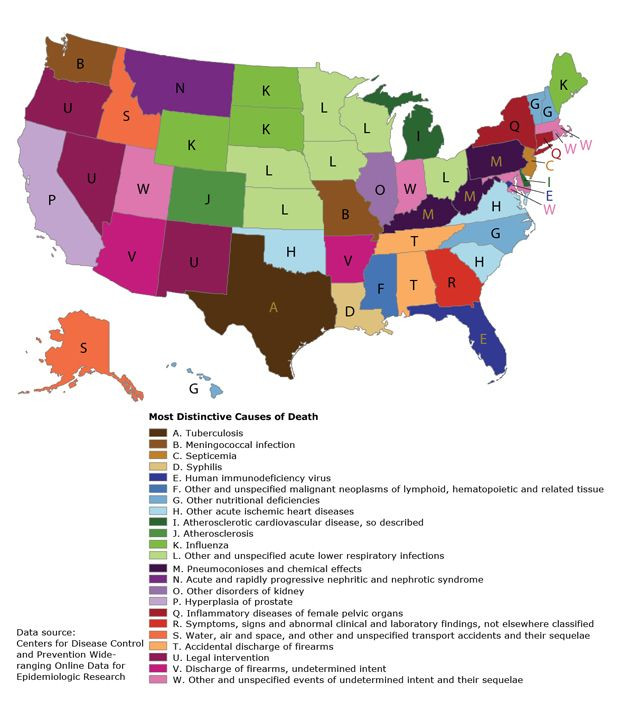Death And Dying In America: CDC's Map Shows 'Distinctive' Cause Of Death In All 50 States

Heart disease, cancer, and diabetes are among the leading causes of death in the U.S., whether you live in New York or California. However, this isn’t the same when it comes to the “distinctive” causes of death by state. According to a recent Centers for Disease Control and Prevention (CDC) study published in the journal Preventing Chronic Disease, where you live in the U.S. will have a good deal to do with how you will die.
"Although chronic-disease-prevention efforts should continue to emphasize the most common [national] conditions, an outlier map such as this one should also be of interest to public health professionals," wrote study authors Francis P. Boscoe and Eva Pradhan, in their report.
Initially, the researchers sought to determine the most distinctive causes of death for each state by looking at a list of 113 causes of death from the International Classification of Diseases, 10th Revision (ICD-10). The death rate from each cause was calculated and then divided by the rate of death from that particular cause in the U.S. This allowed them to see what states had higher rates of death from certain causes than the rest of the U.S. from 2001 through 2010.
The most notable distinctive cause of death was sexually transmitted infection resulting in a relatively high number of deaths. For example, in New York, gonorrhea and chlamydia are the most “distinctive” killers, while pelvic inflammatory disease is the number one unusual cause of death in the state. HIV was the most distinctive cause of death in Florida, where about 15,000 people died from the disease. This is especially alarming since more than 1.2 million people in the U.S. live with HIV and 14 percent are unaware of their infection, according to the CDC.

In other states, like Louisiana, Montana, and Texas, causes of death were quite rare. In Louisiana, syphilis was responsible for 22 deaths, while 11 people in Montana died of rapidly progressive nephritic and nephrotic syndrome — a type of kidney disease — and 674 people died of tuberculosis in Texas. Not surprisingly, the flu was the most distinctive cause in a pocket of northern states such as Maine, North Dakota, South Dakota, and Wyoming.
The researchers make note this is not the most common cause of death in each state, but rather it’s an unusual cause of death that is disproportionately common in each state. Also, the differences in how certain states label a cause of death could influence the results."If something is almost nonexistent everywhere in the country, but there's a handful of them in one state, then that could show up" on the map, Boscoe told LiveScience.
Causes of death are supposed to be coded on death certificates in a standard way, according to Boscoe, but states may do things differently. For example, 24 percent of all U.S. deaths from “other acute ischemic heart diseases” came from Oklahoma, although this state only accounts for one percent of the U.S. population.
The findings should be taken with a grain of salt, since they only depict one distinctive cause of death for each state. These statistics were just significantly higher than the average national rate, while others were not included in the map. Moreover, the map also showed rare causes of death where the total number of deaths was under 100 in 22 states.
This map, while gruesome, emphasizes how factors like environment and culture can influence the risk of death in each state.
Source: Boscoe FP and Pradhan E. The Most Distinctive Causes of Death by State, 2001-2010. Prev Chronic Dis. 2015.
Published by Medicaldaily.com



























